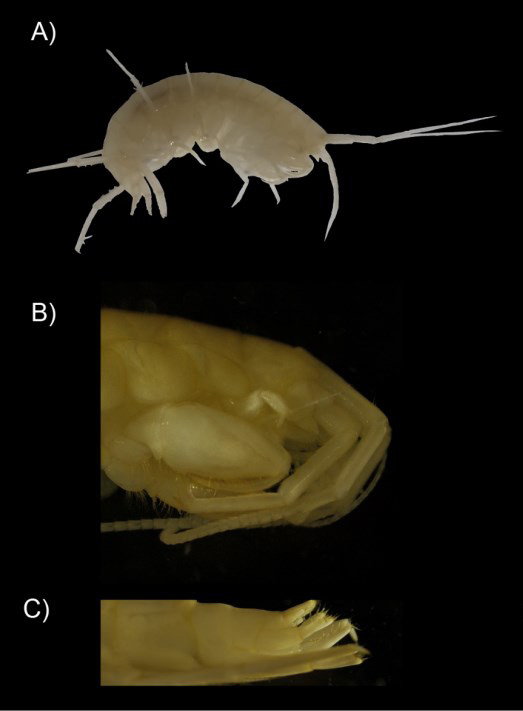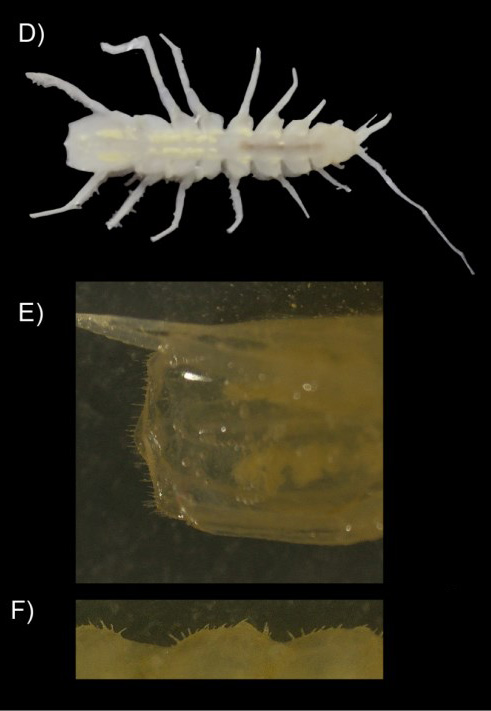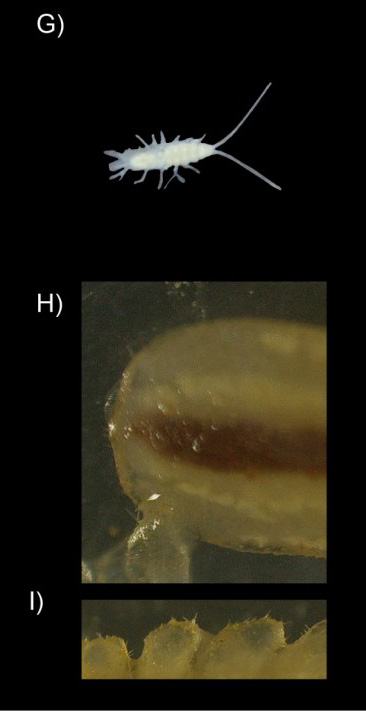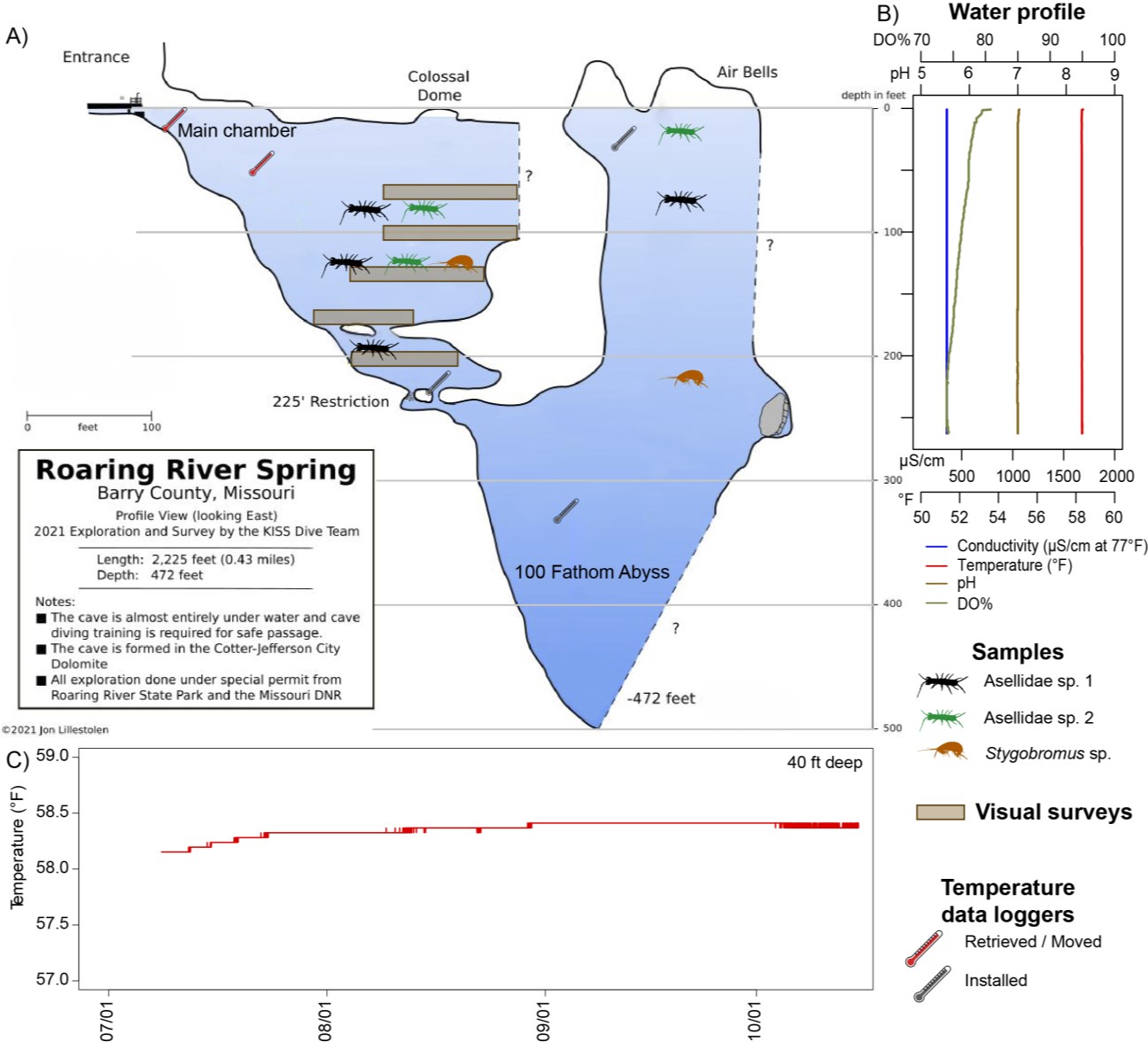TROUT TIMES: Crustaceans collected in Roaring River Spring

Work continues to identify types of life in cave
By Kyle Troutman ktroutman@cassville-democrat.com
The KISS Rebreathers dive team has already made history at Roaring River State Park by diving 472 feet into the spring cave, and during their journeys into the abyss, they may have returned with a new type of crustacean.
A report entitled “Hydrological and biological characterization of Roaring River Spring” was published by the KISS Rebreather exploration team and Fernando Calderon Gutierrez in December 2022.



“Missouri has one of the highest biodiversity of aquatic cave-adapted fauna (stygobionts) in the United States,” the report’s abstract said. “Still, the biodiversity of stygobiont species in Missouri is under-described since several underwater caves remain unexplored, and genetic analyses have the potential to discover species previously unidentifiable.
“The hydrological and biological characteristics of the Roaring River Spring cave have not been previously investigated. During this exploration, it was observed that water parameters are bathymetrically homogeneous at one point in time but have slight variations through time. Roaring River Spring cave is inhabited by at least one species of amphipod, two species of isopods, and one species of salamander. Further biological exploration and analyses of the biodiversity of Roaring Spring cave are needed.”
Amphipods are typically less than 10 millimeters long (about .4 inches), but can be up to 340 millimeters long (13 inches), and are similar to shrimp with no carapace and laterally compressed bodies. They are mostly marine animals, but some can be terrestrial.
Isopods range from .3 millimeters (.012 inches) to nearly 50 centimeters (20 inches) and are similar to lice. They can live in water or on land, and most terrestrial forms are found in cool, damp places.
The report describes the sections of the cave — the entrance, cavern and twilight regions — and what typically inhabits them.
“Most descriptions and identifications of species inhabiting underwater caves are based on morphological taxonomy; however, the evaluation of genetic data reveals cryptic species are widespread,” it said. “Cryptic species can be identified through DNA barcoding methods which can aid in identifying organisms to species level by comparing conserved gene fragments.”
Missouri is fourth in the nation for biodiversity of stygobionts, with more than 40, but no data exists for what may be in the spring.
During their exploration, divers monitored water temperature at 15-minute intervals in multiple locations — 3, 40 and 220 feet deep in the main room; 100 and 330 feet deep in the fathom abyss; and 20 feet deep under the air bells.
Specimens were collected in July, August and September of 2022, corresponding with fauna collection and biological visual surveys.
During the time dedicated to biological exploration, three species of crustaceans were observed, two isopods and one amphipod. Furthermore, divers observed one cave salamander in May 2022. Nine of each isopod were collected, and two of each amphipod.
The first isopod, Asellidae sp. 1, was collected in the depth range of 78-196 feet, and the second, Asellidae sp. 2, was collected from 23-135 feet. The Amphipod, Stygobromus sp., was collected in a range of 86-221 feet.
“COI sequences of the three species of crustaceans and one 16S sequence were obtained,” the report said. “The amphipod was identified to the genus level as Stygobromus, with a similarity of 92.7% to the closest match (Stygobromus ozarkensis) both with Blast and BOLD system. The isopods were identified to the family level as Aselloidae, with higher comparable similarities with four to five genera. The most similar sequences for both isopods corresponded to different species, thus supporting the field observations that they belong to different species.
“The COI sequence of the larger isopod (Asellidae sp. 1) was similar to: Bragasellus, Caecidotea, Lirceus, and Proasellus. The COI and 16S sequences of the smaller isopod (Asellidae sp. 2) concurred similarity were: Caecidotea and Lirceolus. Further molecular and morphological work is needed, including PCR optimization and phylogenetic reconstruction with the novel sequences and those published in NCBI and BOLD in order to conclude a final identification.”
The report said the crustaceans were observed at the ceiling of the ledges of the cave where rock is exposed, as opposed to other areas of the cave covered by sediment. Both species of isopods were abundant, with Asellidae sp. 2 as the dominant species, while the amphipod Stygobromus sp. was rare, with only three individuals observed, none of them inside of the biological visual surveys. The distribution of the fauna is heterogenetic, with isopods forming small aggregations. Further statistical analyses are going to be performed with biological visual survey data.
The report was dedicated to Eric Lee Hahn, the 27-year-old Blacksburg, Va., diver who died during a dive in September due to an improper mixture of air in his tank.
“He was not just an invaluable team member, but a great friend to everyone on the KISS rebreather exploration team,” the report said.
The report also thanked Missouri State Parks, Roaring River Resort and RV Park and the Cassville community for all the support offered for the project, as well as Dr. Elizabeth Borda for the supporting molecular analysis.




